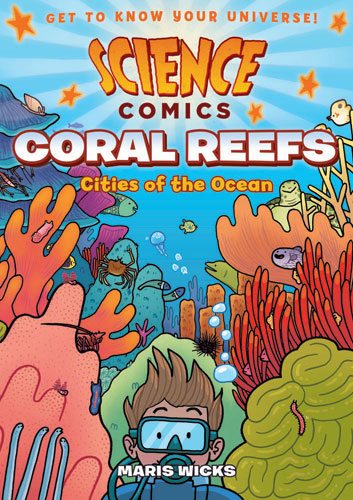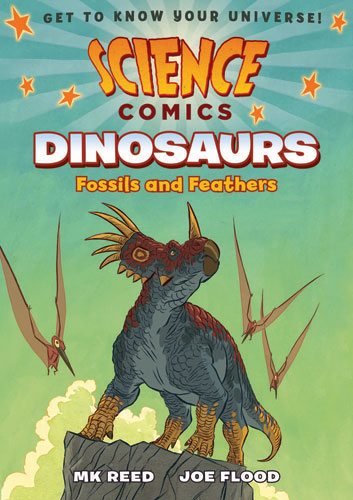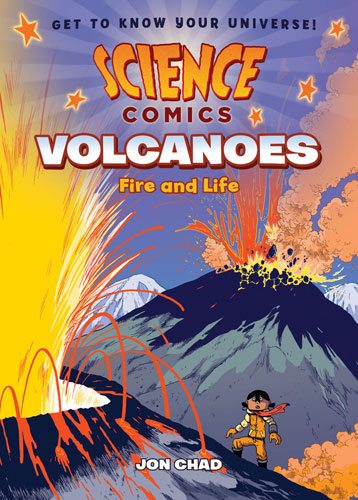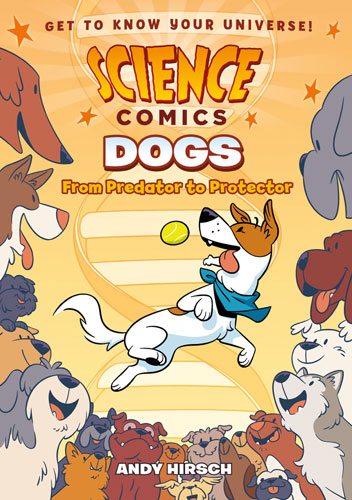As long time Stack Overflow readers know, First Second Comics is one of my favorite comics publishers. It finds some of the best stories, and it makes some really great-looking books. When somebody’s just getting into comics and they want recommendations, you can be sure that there will be a few First Second titles on it.
While First Second does a smash-up job with fictional comics—both for kids and adults—it also has a fantastic line-up of non-fiction comics, too. In particular, they have a series called Science Comics, which launched in March 2016 and will have its seventh title at the end of this month. In today’s column, I’ll take you on a trip through the Science Comics library!
The Science Comics books are fairly slim volumes, a little over 100 pages each, and they’re available in both paperback and hardcover at release so you can pick your preference. Each one has an introduction by an expert in the field, and is accompanied by glossaries and bibliographies and other resources in the back. They make excellent resources, and although they’re written to be kid-friendly, I’ve learned a few things from reading them myself, too!
Coral Reefs: Cities of the Ocean by Maris Wicks
Coral Reefs and Dinosaurs (see below) were the first two books in the Science Comics line, published in March 2016. Coral Reefs was written and illustrated by Maris Wicks, who also published Human Body Theater with First Second, and I really like her approach to non-fiction comics. In Coral Reefs, our guide is a cartoony yellow prawn-goby, who takes us on a tour of reefs, from how they’re formed to what lives in them to how reefs are connected to, well, us. How our actions and choices can affect reefs, and how reefs have benefited us. The book is beautifully illustrated, using a cartoony style for the goby and sometimes for metaphors, but usually using a fairly realistic style for the reefs themselves and the creatures that live there.
One thing I learned from Coral Reefs: there is more biodiversity in coral reefs (in number of phyla found there) than in a rainforest. I also really loved the close-ups showing examples of different types of coral.
Dinosaurs: Fossils and Feathers written by M.K. Reed, illustrated by Joe Flood
Dinosaurs was the other flagship title, published in March 2016, and I’m sure this topic was chosen because, hey, who doesn’t love dinosaurs?
Reed and Flood show us the world of dinosaurs as we understood it in different points in history. In 1800, we were certain that the Earth was 6,006 years old, dinosaurs were monsters that lived a few thousand years ago until they died in Noah’s flood, and there are no living examples of dinosaurs. By 1854, we were certain that the Earth was 400,000 years old, that dinosaurs were reptiles, and they died out for unknown reasons. Dinosaurs shows us how our concept of dinosaurs—and the Earth—has changed over time as more fossils have been discovered and our understanding of animals has grown. Today’s dinosaurs look much different from the ones I grew up with—some have feathers, and their tails don’t drag on the ground.
In a great example of our ever-updating knowledge, the book includes the story of Brontosaurus, a dinosaur that didn’t actually exist. In 1903, it was proposed that the brontosaurus was actually a mash-up of two incomplete skeletons … or was it? Just before the publication of this book, more research revived the brontosaurus—too late to rewrite the book, but early enough to have a humorous last-page addendum.
Dinosaurs is fantastic for its look at the wild, competitive world of paleontology, and the way we continue to refine our understanding of dinosaurs. One thing I learned from Dinosaurs: there’s a dinosaur named Yinlong (“hidden dragon”) after the moving Crouching Tiger, Hidden Dragon, because the movie was filmed near where the fossils were discovered.
Volcanoes: Fire and Life by Jon Chad
Volcanoes was published in November 2016. Jon Chad, the author and illustrator, is no stranger to digging deep into the earth. Several years ago, he published Leo Geo and His Miraculous Journey Through the Center of the Earth, which taught a lot of factoids about geology even as Leo took a fanciful journey filled with crazy underground beings and creatures.
Volcanoes doesn’t populate the center of the earth with a subterranean civilization bent on invading the land-dwellers, but it does have a fictional framing story. Aurora lives on an Earth that has fallen into another ice age: California is buried in snow, and her tribe scours abandoned buildings for fuel to heat their dome. When they come across a trove of books, they scan them into digital form before using the books as fuel—and Aurora happens to come across a book about volcanoes.
For the rest of the book, Aurora tries to convince her siblings and teacher that they should be looking for volcanic sources of heat rather than searching farther and farther afield for diminishing supplies of fuel. Aurora explains all the things she’s learned, like what’s under the Earth’s crust, how volcanoes form, and the different types of volcanoes and eruptions. The book’s mix of fiction and non-fiction might not appeal to everyone—there are some parallels between what’s happening in the story and what Aurora is explaining from the book, but not always, so it’s more like non-fiction sections inserted into a sci-fi story. But for readers who want a little more narrative than typical non-fiction books, the story might pull them in more.
One thing I learned from Volcanoes: Devils Tower in Wyoming is a volcanic neck—a hardened core of magma—that was revealed when the outer rocks of a volcano wore away. Cool!
Bats: Learning to Fly by Falynn Koch
Bats was published in February 2017. Falynn Koch first introduces us to Little Brown Bat, who is far from home and happens upon a group of (human) tourists admiring some nectar bats in the desert. Although Little Brown is just trying to catch some insects to eat, some of the folks freak out, and Little Brown ends up injured.
When Little Brown wakes up, he’s at an animal rehab center, along with a bunch of other recovering bats. As he meets his new roommates, we get an education about bats: how they fly, what they eat, why they’re an important part of the ecosystem, and so on. At first, Little Brown feels left out because nectar bats seem to get all the love from humans, but soon he discovers that every type of bat has some really cool abilities or features.
One thing I learned from Bats: bats are closely related to primates, not to rodents. Another thing: the largest urban bat colony in the world is in Austin, Texas, under the Congress Avenue Bridge, which even has a bat statue on it.
Flying Machines: How the Wright Brothers Soared written by Alison Wilgus, illustrated by Molly Brooks
Flying Machines was published in May 2017. The narrator in this book is Katharine Wright, the youngest of the five Wright children and the only girl. It turns out that she was a very significant figure in the story of Orville and Wilbur’s experimentations with flight, and later became essentially the PR department for the Wrights. Without her support and championing of her brothers, the Wrights might have gotten the credit for heavier-than-air flight.
Katharine is telling a classroom of bored kids about the early days of flight, giving examples of different types of aircraft that people attempted to fly, the theories behind their contraptions, and so on. There is, of course, a focus on the Wright brothers, and how their approach differed from many of the others. Later on, there is also a bit more about Frank Whittle, who believed that a turbine engine could make planes go much faster—the Wrights and Whittle laid the groundwork for modern jet planes.
One thing I learned from Flying Machines was how secretive the Wrights were about their work, and how the French flight enthusiasts doubted their claims. Even after the Wrights had achieved sustained, controlled flight, very few people believed it until they saw it for themselves—but once they did, the world changed!
Plagues: The Microscopic Battlefield by Falynn Koch
Plagues was published in August 2017. Falynn Koch, who also wrote and illustrated Bats, takes us into the microscopic world of plagues: viruses, bacteria, and protozoa, oh my!
This book has a framing story set in a future where scientists are able to communicate with microorganisms. Elena is a new tech at CHAMBER, the Center for Holographic Advanced Microorganism and Bio-Engineering Research, and she is using a special holographic simulation to talk to Yellow Fever and Bubonic Plague, along with one of her own T Cells. Elena is trying to recruit Yellow and Bub to team up with CHAMBER to fight disease instead of causing it, and along the way we learn a lot about how diseases spread, the different types of microorganisms that can cause diseases, and how our bodies combat them.
The illustrations of the microscopic world are cartoony—everything has a face—but still mostly based on actual appearances. (I’m guessing our B Cells don’t actually have a Western-style sheriff’s badge and handlebar mustaches.) The book describes some of the worst plagues in history, as well as some of the scientific advances that help us treat diseases, like using viruses to deliver vaccinations.
One thing I learned from Plagues: those funny pointed nose masks worn by doctors during the Black Plague were filled with herbs to protect them from “bad air,” which was thought to be the cause of the plague. The reason it actually worked was because it protected them from pneumonic plague, which spread through coughing.
Dogs: From Predator to Protector by Andy Hirsch
Dogs will be published at the end of this month, October 2017. Andy Hirsch is also the illustrator of The Baker Street Peculiars, which I covered in this Stack Overflow column, so his style was a little familiar to me (though, of course, Baker Street Peculiars had a lot more people in it, and this one has a lot more dogs).
Our tour guide in Dogs is Rudy, a mutt who’s very excited about chasing down his ball. And as he chases the ball, he zips into other times and places (through the magic of comics). We get to see where the first domesticated dogs came from—or didn’t come from, the incredible senses that dogs have, and how dog breeds work. Along the way, we get a brief primer on genetics, dominant and recessive genes, and natural selection. All of it adds up to explain how we ended up with dogs as pets—and why there are so many different breeds but they’re all considered one species.
I really enjoyed Dogs, even though—I must confess—I’m not a dog person and am generally not too fond of them. So even as somebody who typically prefers other topics, I found myself really engaged by this book. Rudy makes a great teacher, and the facts are woven into the framing story really well.
One thing I learned from Dogs: in 1959, Dmitry Belyaev in Siberia conducted breeding experiments with silver foxes, going from wild, aggressive foxes to friendly, tame foxes in a relatively short amount of time. (Relative to natural evolution, that is.) I also found it fascinating the way that the foxes’ phenotypes (physical appearances) changed along with their behavior.
But wait—there’s more! There are more Science Comics coming in 2018: Robots & Drones, Sharks, Rockets, and Trees. I’m excited to see how these turn out, and to continue learning with my kids!
I highly recommend the Science Comics series. They’re great for elementary school kids and up, and I think they would also be excellent resources for classrooms and school libraries.
Here’s more about these books and First Second from GeekDad and GeekMom:
- Rebecca Angel’s review of Coral Reefs and Dinosaurs on GeekMom
- Rebecca Angel’s review of Bats on GeekMom
- Rebecca Angel’s review of Flying Machines on GeekMom
- Jamie Greene’s interview of Alison Wilgus and Molly Brooks on GeekDad
- My celebration of First Second’s 10th anniversary
Disclosure: I received review copies of these titles.












